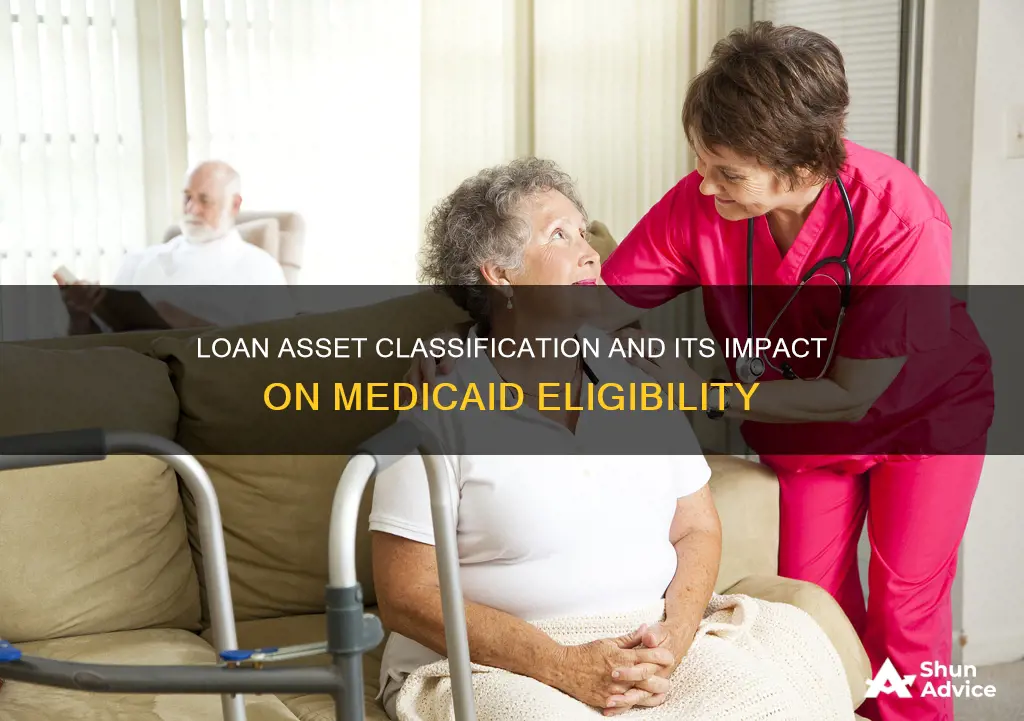
The process of determining Medicaid eligibility is complex, and there are various factors to consider. One critical aspect is assessing an individual's assets, which can include cash, bank accounts, investments, real estate, vehicles, and life insurance policies. Notably, the treatment of loans in this context is nuanced. While loans themselves may not be considered assets, the Deficit Reduction Act (DRA) of 2005 includes loans in its definition of assets with respect to transfer of asset penalties. This means that funds used to purchase certain notes and loans can be considered assets for Medicaid eligibility purposes. Additionally, mortgages can be structured as assets or income streams, depending on the specific circumstances. Understanding these nuances is crucial for individuals seeking to qualify for Medicaid while managing their financial resources effectively.
| Characteristics | Values |
|---|---|
| Medicaid loan strategy | The "gift and loan" strategy involves gifting half of one's assets to family members and lending the other half to them, with the understanding that they will repay the loan with interest. During the loan repayment period, the applicant can apply for Medicaid benefits, which will kick in once the loan repayment period is over. |
| Medicaid spend-down strategy | The process of reducing the value of one's assets to qualify for Medicaid is called "spending down." This can involve spending cash or selling "countable" assets like stocks or extra vehicles. Allowable spend-down items include prepaid funeral expenses, mortgage payments, car loans, and credit card debts. |
| Medicaid countable assets | Countable assets, or resources, are calculated towards Medicaid's asset limit and include cash, stocks, bonds, investments, vacation homes, and bank accounts. |
| Medicaid non-countable assets | Exempt, or non-countable, assets generally include one's primary home, personal belongings, household items, one vehicle, burial funds or life insurance policies up to a certain value, and non-refundable prepaid funeral agreements. |
What You'll Learn

Medicaid's definition of a countable asset
To qualify for Medicaid, an applicant must have income and assets under a specified amount. This amount varies by state, and each state has different rules and exemptions. For example, in 2021, New York automatically excluded applicants with assets above $15,900 for an individual and $23,400 for a family.
Countable assets, also referred to as liquid assets, are those that are easily converted to cash. These include cash, bank accounts, vacation houses and property other than the primary residence, mutual funds, stocks, bonds, and certificates of deposit. Retirement accounts, such as 401(k)s and IRAs, are also considered countable assets in approximately 30 states.
Non-countable assets, on the other hand, are not counted towards the asset limit. These typically include an applicant's primary home, personal property, household goods, and furnishings, as well as prepaid funeral and burial arrangements up to a certain amount.
It is important to note that some assets, such as loans, may be treated differently by Medicaid. For example, in the case of a loan given to family members, Medicaid may impose a penalty period during which they refuse to pay, considering the loan as a gift. However, if the loan is to be repaid with interest, as per a promissory note, Medicaid may not consider it a gift and may provide coverage after the penalty period ends.
To navigate the complexities of Medicaid rules and determine which assets are countable and non-countable, it is advisable to consult a legal practitioner experienced in elder law or a Medicaid planning attorney. They can provide personalized advice and help protect assets while ensuring eligibility for Medicaid benefits.
Stimulus Package: EIDL Loans Included or Excluded?
You may want to see also

The 'gift and loan' strategy
The gift and loan strategy is an advanced elder law technique used to protect assets at the last minute when a person is about to enter a nursing home. It is also known as the "half a loaf" strategy. This strategy is particularly useful when the person has not planned ahead by purchasing long-term care insurance or creating a Medicaid Asset Protection Trust.
Assume that a person is about to enter a nursing home that costs $10,000 per month, and they have $300,000 in assets that they want to pass on to their children as an inheritance. Using the gift and loan strategy, the person would first gift one-half of their assets, or $150,000, to their children. Then, they would lend the remaining $150,000 to their children, who would execute a promissory note agreeing to repay the loan in monthly installments of $10,000, plus interest.
At this point, the person can apply for Medicaid benefits. Medicaid will impose a penalty period, typically equal to the number of months that the gifted amount could have been used to pay for care. In this case, the penalty period would be 15 months. Medicaid ignores the loan since it is not a gift and will be repaid with interest according to the terms of the promissory note. During the penalty period, the loan repayments will be used to pay for the person's nursing home care. Once the penalty period expires, Medicaid will begin covering the costs. As a result, the children get to keep the $150,000 gift, and the person has successfully passed on a portion of their assets as an inheritance.
It is important to note that the gift and loan strategy should only be done under the guidance of a qualified elder law attorney, as there are complex calculations and specific requirements that must be considered for this approach to be effective. Additionally, the rules and limits regarding Medicaid eligibility vary by state, so it is essential to consult with a professional to ensure compliance with the applicable laws and regulations.
Jumbo Loan Size: Expansion and Impact on Borrowers
You may want to see also

Medicaid's spend-down amount
The process of reducing the value of your assets to qualify for Medicaid is referred to as "spending down". This involves spending cash or selling "countable" assets, such as stocks or extra vehicles, and then spending that money. It's important to note that not all assets need to be liquidated to qualify for Medicaid. Each state has different rules and allowances for what is considered an allowable Medicaid spend-down item.
Medicaid applicants can prepay their mortgages, as they are legally obligated to pay the full amount of the loan. However, prepaying a mortgage increases the owner's equity in the house, and Medicaid will only ignore a certain amount of equity in an applicant's home. Other common assets that are usually not counted towards the asset limit by Medicaid include one car, personal effects, household goods and furnishings, some prepaid funeral and burial arrangements, and a limited amount of cash.
To determine your spend-down amount, you need to calculate the difference between your income and the Medicaid eligibility limit set by your state over a given period, typically between one to six months. This amount can vary depending on factors such as your marital status, living arrangements, and other factors. If your income is higher than the Medicaid limits, a spend-down will allow you to use extra money on medical expenses until you qualify.
It's important to be cautious when spending down your assets, as there are rules and restrictions in place. For example, you cannot give away assets for less than they're worth within five years of applying for Medicaid. Additionally, some states may require you to submit receipts or bills to Medicaid to show your monthly expenses, while others may allow you to pay a monthly premium directly to Medicaid for the amount that your income exceeds the state's Medicaid spend-down level.
Loan Modifications: Spouse Signature Requirements and Exemptions
You may want to see also

Countable vs. non-countable income
When it comes to Medicaid, not all of an applicant's income is considered in determining their eligibility. Some portions of an applicant's income are "uncounted" or "disregarded". The specific rules and limits vary by state and an applicant's marital status, living arrangements, and other factors.
Countable Income
Countable income is the portion of an applicant's income that is considered when determining their eligibility for Medicaid. For single applicants, the process is relatively straightforward: all countable monthly income is added up and counted towards the income limit. For married couples, the process is more complex, as Medicaid typically counts the assets of both spouses. However, when only one spouse is applying, and that spouse does not have many assets, they may be allowed to keep a certain amount, known as the Community Spouse Resource Allowance (CSRA). The CSRA varies by state but typically ranges from $30,828 to $154,140.
Examples of countable income include Social Security benefits, annuity income, alimony payments, disability payments, pension payments, dividends from bonds and stocks, interest payments, IRA distributions, gifts/inheritances, net rental income, and Veterans' benefits (with the exception of Aid & Attendance payments).
Non-Countable Income
Non-countable income, also referred to as disregarded, excluded, or uncounted income, is the portion of an applicant's income that is not considered when determining their eligibility for Medicaid. Non-countable income can include certain deductions, such as a general income deduction or an earned income deduction. For example, in some Medicaid programs in Mississippi, a $20 or $50 general income deduction is applied. Additionally, a Medicaid applicant may be able to deduct a certain amount from their earned income, such as $65 plus half of any remaining earned income.
It's important to note that non-countable income can vary by state and specific circumstances. For instance, Holocaust restitution payments are considered non-countable income and do not impact eligibility.
Spending Down
The process of reducing one's assets to qualify for Medicaid is known as "spending down." This can involve spending cash or selling countable assets, such as stocks or extra vehicles, and then spending that money. It's important to note that assets cannot be given away for less than they are worth within five years of applying for Medicaid. Additionally, certain assets, such as one's home (in some circumstances), one car, personal effects, household goods, and a limited amount of cash, are typically not required to be sold or spent to qualify for Medicaid.
China's Debt: America's Multi-Million Dollar Question
You may want to see also

The Promissory Gift/Loan Plan
The plan starts by considering factors such as the daily rate of the nursing home, monthly medical expenses, the applicant's gross income, permissible deductions, the total value of assets in the applicant's name, and the value of prior transfers. Based on these factors, elder law attorneys can determine the size of the gift and the loan that can be made, as well as the loan's repayment terms.
In the context of Medicaid planning, the gift portion of the plan acknowledges that a penalty period will be imposed due to the transfer of assets to family members. This penalty period is calculated based on the total value of uncompensated transfers made within a certain timeframe before the Medicaid application. The note portion of the plan, or the promissory note, specifies the repayment rate and the length of repayment, which ideally aligns with the penalty period.
The effectiveness of this strategy lies in the fact that Medicaid treats gifts and loans differently. The gifted portion is considered a transfer that triggers a penalty period, during which Medicaid refuses to pay for the applicant's care. On the other hand, Medicaid ignores the loaned portion as it is expected to be repaid with interest according to the terms of the promissory note. The loan repayments can then be used to pay for the nursing home care during the penalty period. Once the penalty period expires, Medicaid begins to cover the expenses.
It is important to note that the promissory note must meet certain legal criteria to be valid under Medicaid eligibility rules. Additionally, the interest rate charged on the loan should be considered, as some rules apply to family loans above certain thresholds. Consulting with elder law attorneys, such as Burke & Casserly, can help individuals understand how the Promissory Gift/Loan Plan might work in their specific situations.
Understanding the Paycheck Protection Loan Repayment System
You may want to see also
Frequently asked questions
A loan can be considered an asset for Medicaid purposes, but it depends on the type of loan and the circumstances. For instance, a mortgage is considered an asset, and its value is the amount left to be paid on it, not the original loan amount. However, careful planning and specific strategies, such as the "note and loan" strategy, can help protect assets and manage eligibility for Medicaid.
Medicaid considers various assets when determining eligibility, including cash, bank accounts, investments, real estate (beyond the primary residence), vehicles (beyond one car), and life insurance policies. Retirement accounts like IRAs and 401(k)s may also be counted, depending on the state.
Yes, certain assets are typically exempt from Medicaid eligibility considerations. These include an individual's primary residence, one car, personal effects, household goods, some prepaid funeral arrangements, and burial spaces. Additionally, assets in certain types of trusts, such as Medicaid Asset Protection Trusts and irrevocable trusts, may also be exempt.







